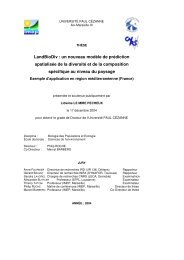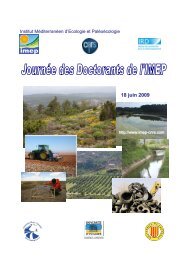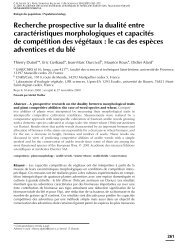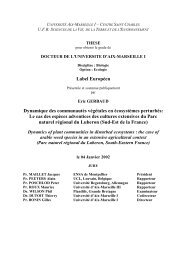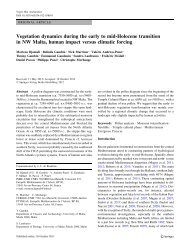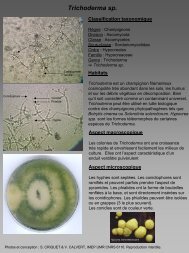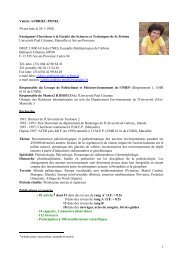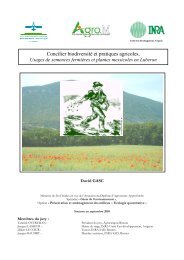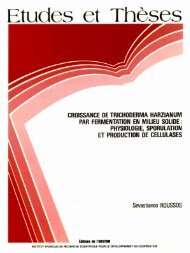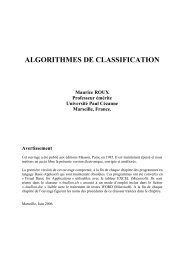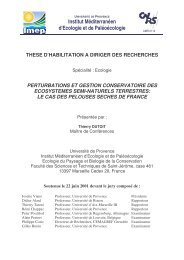UNIVERSITÉ PAUL CÉZANNE, AIX MARSEILLE III - IMEP
UNIVERSITÉ PAUL CÉZANNE, AIX MARSEILLE III - IMEP
UNIVERSITÉ PAUL CÉZANNE, AIX MARSEILLE III - IMEP
Create successful ePaper yourself
Turn your PDF publications into a flip-book with our unique Google optimized e-Paper software.
1. Introduction<br />
Résultats et discussion. Chapitre 2: Optimisation de la production du spawn<br />
Ergosterol is principal sterol present in fungi biomass (Czub and Baginski, 2006) with<br />
its two forms, as free ergosterol and esterified ergosterol. The relative abundances of free to<br />
esterified ergosterol are different among the various species of fungi (Czub and Baginski<br />
2006; Yuan et al., 2007). Therefore, the determination of ergosterol consists in measuring of<br />
living fungal biomass, because of the assumption of its instability after death of biomass<br />
(Mille-Lindblom et al., 2004). This ergosterol was also subject for certain investigations in<br />
order to study its conversion to Vitamin D2 (Jasinghe and Perera, 2005; 2006) which has been<br />
suggested for therapeutic applications in the treatment of several diseases including<br />
hyperproliferative diseases, secondary hyperparathyroidism, post-transplant survival, and<br />
various malignancies (Morgan, 2001).<br />
Culture of L. edodes attracks attention of several authors for its proved medicinal<br />
properties and antimicrobial effect (Kitzberger et al., 2007; Israilides et al., 2008; Rao et al.,<br />
2009) and biodegradation as well as biotransformation abilities of phenolic compound as<br />
lignin by producing large spectrum of enzymes involved in transformation of these<br />
recalcitrant compounds (Philippoussis al., 2007). While the kinetics of growth of the<br />
mycelium is related to nutritional and environmental factors, several authors (Mamiro and<br />
Royse 2008; Kuforiji and Fasidi 2009; Royse and Chalupa 2009) demonstrated that the high<br />
quality crop of mushroom depends primarily on the quality of the spawn, which in turn<br />
depends on the purity and size of biomass and physiological state of the culture. However,<br />
direct quantification of biomass during spawn running is very difficult or even impossible,<br />
owing to the problem of separating the fungal mycelium from the substrate, where the fungal<br />
hyphae penetrate into and bind tightly to the substrate (Bellon-Maurel et al., 2003; Singhania<br />
et al., 2009).<br />
However, several techniques of indirect fungal biomass in Solid state fermentation<br />
(SSF) were reported depending to measuring the biological activity (e.g respiration O2 intake<br />
and/or CO2 production) or measuring the content of certain cell components. Recently digital<br />
image processing has been developed as a tool for measuring of biomass of Aspergillus niger<br />
strains in SSF (Couri et al., 2006). The growth of this strain was quantified as the total area<br />
occupied by the hyphae, while this technique was poorly correlated with glucosamine test.<br />
The drawback of this technique consists in setting up of the focus and illumination parameters<br />
which become more difficult when complex substrates are used (Couri et al., 2006).<br />
76



